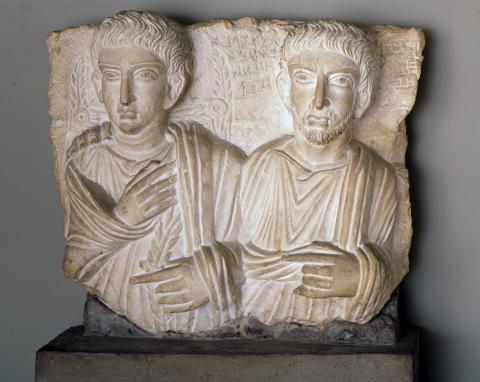Funerary Portrait: Sabdibel and Yarkhibonna
Funerary Portrait: Sabdibel and Yarkhibonna
Late Antique (Palmyra), ca. 150-200 CE
limestone
height 54.6 cm
width 58.4 cm
depth 20.3 cm
Inscription in Aramaic
Portland Art Museum European Collection, 54.2
Gift of Mr. Aziz E. Atiyeh
Melissa Medefesser, Medieval Portland Seminar Student, 2015
The display of family lineage was of importance for Palmyrene funerary sculpture. Family members, usually spouses or children, were often represented together on a single bust. The double portrait bust of Sabdibel and Yarkhibonna, is rare with its depiction of only two men. Inscriptions above the shoulders in Aramaic identify them as Sabdibel, whose name is thought to represent "a gift from the god Bel, or Ba'al," and his nephew Yarkhibonna, whose name refers to a moon deity.[1]
The two figures are dressed in the standard male attire for Palmyrene funerary art, the Greek himation or chiton. Sabdibel is depicted with a beard, a trend brought to Palmyra by the Roman Emperor Hadrian in the 2nd century CE.[2] His right arm is placed over the shoulder of his beardless nephew, in a display of affection. The pointing gestures of their left hands convey family ties.[3] A draped cloth held in place by two circular pins, known as a dorsalium, shown behind Yarkhibonna, is an indication that he was the first to die.[4]
Palmyrene funerary sculptures are believed to be idealized portraits of the deceased rather than veristic. This explains the striking similarity in facial features between the two figures.[5] Both figures display thick hair with indented strands and Sabdibel is portrayed with bushier, more naturalistic eyebrows. Two concentric circles enclosed in almond-shaped eyelids define the eyes and drilled holes mark the pupils of the eyes, as well as the outer edges of Sabdibel's lips.
The earliest known records indicate the sculpture was owned by Mr. Elias Mas'ad in Homs, Syria in 1902. It was purchased by Mr. Aziz Atiyeh in 1933 and later donated, along with two other Palmyrene funerary busts, to the Portland Art Museum in 1953.[6]
Notes
[1] Collection Notes, File 54. 1-3, Archives Department, Portland Art Museum.
[2] Harold Ingholt, Palmyrene and Gandharan sculpture; an Exhibition Illustrating the Culture Interrelations Between the Parthian Empire and its Neighbors West and East, Palmyra and Gandhara (Yale University: New Haven, 1954) 2.
[3] Maura K. Heyn, "Gesture and Identity in the Funerary Art of Palmyra, " American Journal of Archaeology 114, no. 4 (2010): 637.
[4] Francis J. Newton, "Three Tomb Sculptures from Palmyra," Notes on the Collection, no. 5 (1964-65), Portland Art Museum.
[5] Heyn, 637.
[6] Newton.
Bibliography
Heyn, Maura K. "Gesture and Identity in the Funerary Art of Palmyra." American Journal of Archaeology 114, no. 4 (2010) 631-661.
Ingholt, Harald. Palmyrene and Gandharan sculpture; an Exhibition Illustrating the Culture Interrelations Between the Parthian Empire and its Neighbors West and East, Palmyra and Gandhara. Yale University: New Haven, 1954.
Newton, Francis J. "Three Tomb Sculptures from Palmyra." Notes on the Collection, no. 5, Portland Art Museum (1964-65).
Portland Art Museum. Palmyrene Sculptures. File 54. 1-3. Archives Department.

